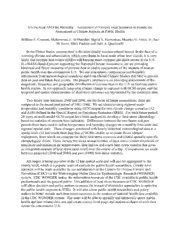
NASA Technical Reports Server (NTRS) 20130010352: It's the Heat AND the Humidity -- Assessment of Extreme Heat Scenarios to Enable the Assessment of Climate Impacts on Public Health PDF
Preview NASA Technical Reports Server (NTRS) 20130010352: It's the Heat AND the Humidity -- Assessment of Extreme Heat Scenarios to Enable the Assessment of Climate Impacts on Public Health
It’s the Heat AND the Humidity – Assessment of Extreme Heat Scenarios to Enable the Assessment of Climate Impacts on Public Health William L. Crosson, Mohammad Z. Al-Hamdan, Sigrid A. Economou, Maurice G. Estes, Jr., Sue M. Estes, Mark Puckett and Dale A. Quattrochi In the United States, extreme heat is the most deadly weather-related hazard. In the face of a warming climate and urbanization, which contributes to local-scale urban heat islands, it is very likely that extreme heat events (EHEs) will become more common and more severe in the U.S. In a NASA-funded project supporting the National Climate Assessment, we are providing historical and future measures of extreme heat to enable assessments of the impacts of heat on public health over the coterminous U.S. We use atmospheric temperature and humidity information from meteorological reanalysis and from Global Climate Models (GCMs) to provide data on past and future heat events. The project’s emphasis is on providing assessments of the magnitude, frequency and geographic distribution of extreme heat in the U.S. to facilitate public health studies. In our approach, long-term climate change is captured with GCM output, and the temporal and spatial characteristics of short-term extremes are represented by the reanalysis data. Two future time horizons, 2040 and 2090, are the focus of future assessments; these are compared to the recent past period of 1981-2000. We are characterizing regional-scale temperature and humidity conditions using GCM output for two climate change scenarios (A2 and A1B) defined in the Special Report on Emissions Scenarios (SRES). For each future period, 20 years of multi-model GCM output have been analyzed to develop a ‘heat stress climatology’ based on statistics of extreme heat indicators. Differences between the two future and past periods have been used to define temperature and humidity changes on a monthly time scale and regional spatial scale. These changes, combined with hourly historical meteorological data at a spatial scale (12 km) much finer than that of GCMs, enable us to create future climate realizations, from which we compute the daily heat stress measures and related spatially-specific climatological fields. These include the mean annual number of days above certain thresholds of maximum and minimum air temperatures, heat indices and a new heat stress variable that gives an integrated measure of heat stress (and relief) over the course of a day. Comparisons are made between projected (2040 and 2090) and past (1990) heat stress statistics. All output is being provided at the 12 km spatial scale and will also be aggregated to the county level, which is a popular scale of analysis for public health researchers. County-level statistics will be made available by our collaborators at the Centers for Disease Control and Prevention (CDC) via the Wide-ranging Online Data for Epidemiologic Research (WONDER) system. CDC WONDER makes the information resources of the CDC available to public health professionals and the general public. This addition of heat stress measures to CDC WONDER will allow decision and policy makers to assess the impact of alternative approaches to optimize the public health response to EHEs. It will also allow public health researchers and policy makers to better include such heat stress measures in the context of national health data available in the CDC WONDER system. The users will be able to spatially and temporally query public health and heat-related data sets and create county-level maps and statistical charts of such data across the coterminous U.S.
